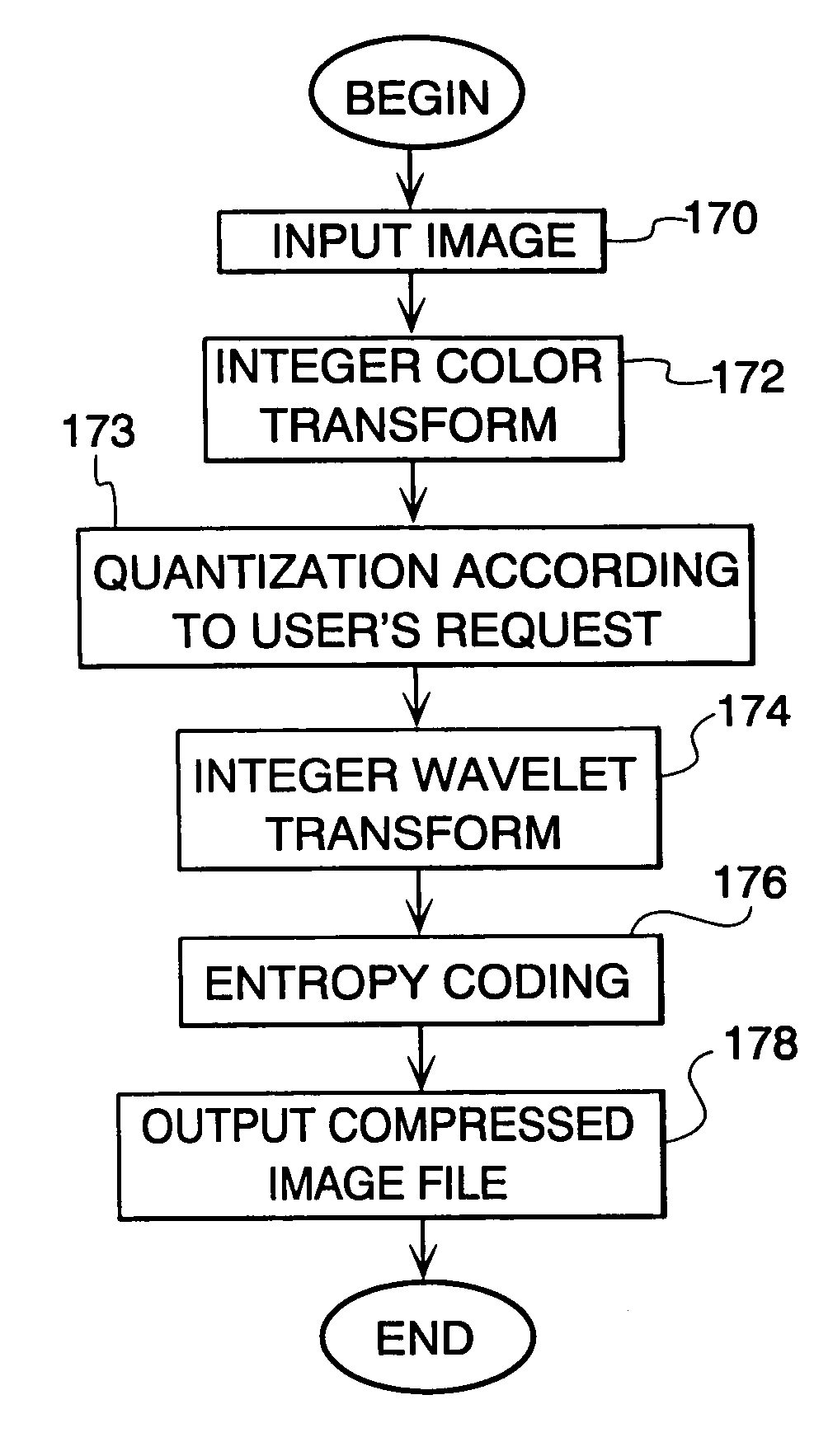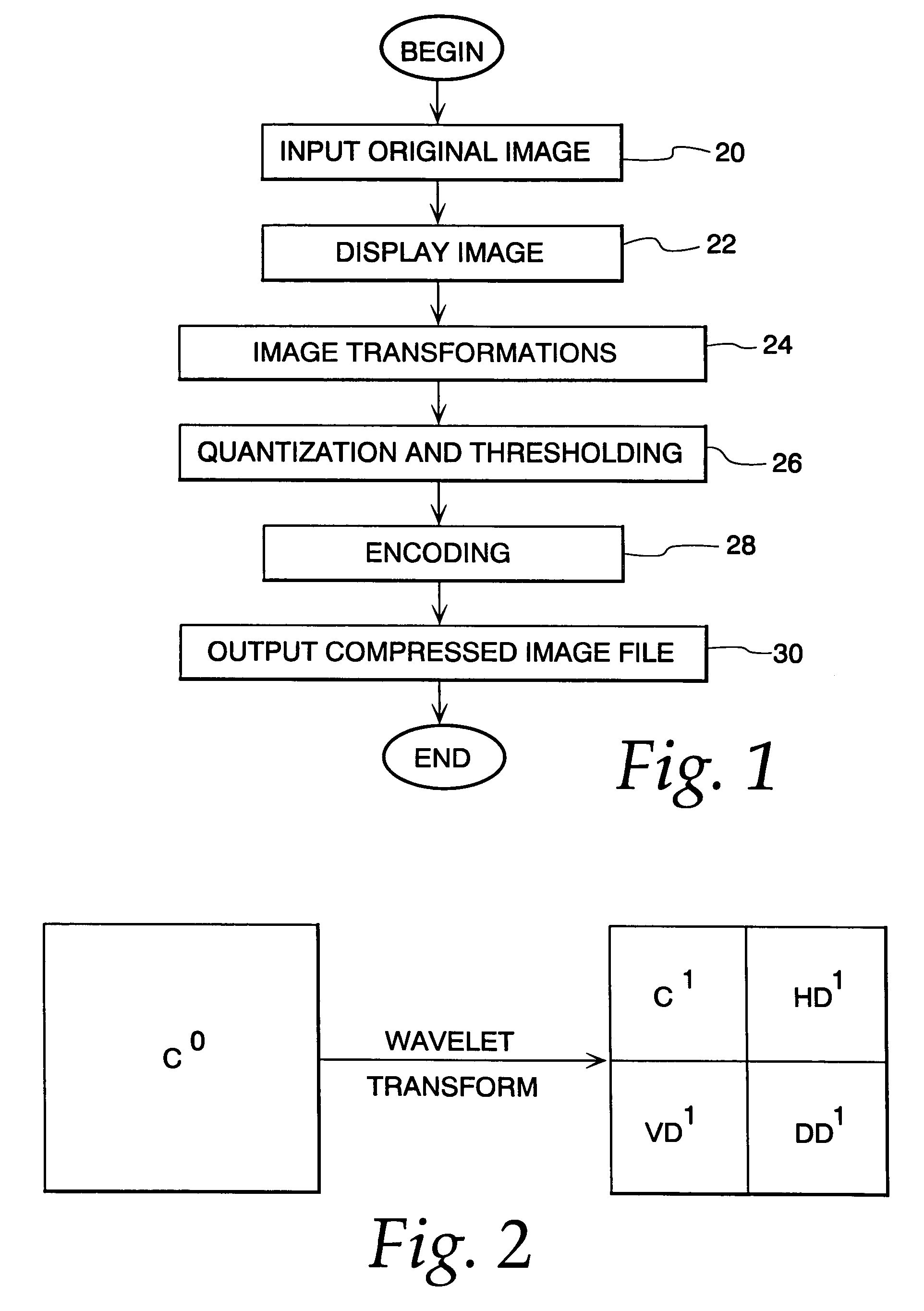Image compression and decompression based on an integer wavelet transform using a lifting scheme and a correction method
a wavelet transform and lifting scheme technology, applied in the field of wavelet-based system and method of image compression and decompression, can solve the problems of etc., and achieve the effect of enhancing the speed of the compression scheme, reducing the time required to perform, and reducing the computer resources needed to compress and decompress images
- Summary
- Abstract
- Description
- Claims
- Application Information
AI Technical Summary
Benefits of technology
Problems solved by technology
Method used
Image
Examples
example 1
A (2,2)-Wavelet Transform by Integer Calculation
[0096]This transformation is similar to a variation of the Haar wavelet transform which uses low and high pass analysis (decomposition) filters given as:
[0097]
n01{tilde over (h)}n½ ½{tilde over (g)}n½−½[0098](1) Compute
dk1=c2k0−c2k+10, k=0, . . . , M1−1 (2.1)[0099](2) Compute ckl=Int(dkl2)+c2k+10,k=0,…,N1-2,cN1-1l={Int(dM1-112)+C2k+10,ifNisanevennumber,cN-10,ifNisanoddnumber.(2.2)
[0100]Here, Int(x) is an arbitrary rounding function which may have different interpretations. For example, Int(x) can be the integer which is nearest to x, or Int(x) may be any integer which satisfies x−1n1}n=0N1−1 and {dn1}n=0M1−1 are integers.
[0101]From (2.1)–(2.2), we can easily get the following integer reconstruction algorithm:[0102](b) Reconstruction[0103](1) If N is an even number, compute: c2k+10=ckl-Int(dkl2),k=0,…,N1-1;(2.3)
or, if N is an odd number, we have c2k+10=ckl-Int(dkl2).k=0,…,N1-2;cN-10=cN1l.(2.4)[0104](2...
example 2
Lazy Wavelet Transform
[0106]The lazy wavelet transform is used to illustrate an important concept. The corresponding inverse transform is nothing else but sub-sampling the even and odd indexed samples. Decomposition and reconstruction can use the same formula as follows:
ck1=c2k0, k=0, . . . N1−1;
dk1=c2k+10, k=0, . . . , M1−1.
[0107]Examples 1 and 2 are not good transforms for image compression, but they are simple. Much better transforms can be achieved from these two. As suggested above, they are considered only as a starting point for the integer, reversible, wavelet transform algorithm of the disclosed invention.
[0108]It is noted that there is another interesting property in the above two transforms which may not be easily seen. If the values of the signal pixels are represented by a finite number of bits, say one bit or one byte, the same number of bits can be used to represent the result of the forward transform within the computer itself because of the complementary code proper...
example 3
A (2.6) Wavelet Transform by Integer Calculation (2)
[0113]This transformation is similar to using the following analysis filters:
[0114]
n−2−10123{tilde over (h)}n00½ ½00{tilde over (g)}n− 1 / 16− 1 / 16½−½ 1 / 16 1 / 16
(a) Decomposition
[0115]Decomposition starts with Example 1 at step (1) and (2), and then upgrades the high frequency component at step (3):
(1) Compute
dk1,0=c2k0−c2k+10, k=0, . . . , M1−1.
(2) Compute ck1=Int(dk1,02)+c2k+10,k=0,…,N1-2,cN1-11={Int(dM1-11,02),+CN-10,ifNisanevennumber,cN-10,ifNisanoldnumber;
(3) Compute { d01=Int(c0-c114),+d01,0dk1,=Int(ck-11-ck+114)-dk1,0,k=1,…,M1-2,
and then, if N is even, calculate dM1-11=Int(cN1-21-cN1-114)-dM1-11,0,
else, calculate dM1-11=Int(cN1-31-cN1-114)-dM1-11,0.
(b) Reconstruction
[0116]The reconstruction algorithm is identical to the decomposition algorithm, except it is now running “backwards”.
(1) Compute { d01,0=Int(c01-c114)-d01dk1,0=Int(ck-11-ck+114)-dk1,k=1,…,M1-2,
and then, if N is even, calculate dM1-11,...
PUM
 Login to View More
Login to View More Abstract
Description
Claims
Application Information
 Login to View More
Login to View More - R&D
- Intellectual Property
- Life Sciences
- Materials
- Tech Scout
- Unparalleled Data Quality
- Higher Quality Content
- 60% Fewer Hallucinations
Browse by: Latest US Patents, China's latest patents, Technical Efficacy Thesaurus, Application Domain, Technology Topic, Popular Technical Reports.
© 2025 PatSnap. All rights reserved.Legal|Privacy policy|Modern Slavery Act Transparency Statement|Sitemap|About US| Contact US: help@patsnap.com



